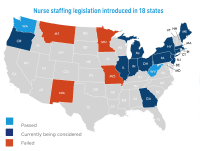The ambush shootings in downtown Dallas last July, which killed five police officers and wounded seven other people, cast a spotlight on gun violence yet again. This and other recent incidents give us an opportunity to talk about the impact of gun violence on nurses and their workplaces. Ironically, ANA’s declaration “Stop the Madness: End the Violence” was released just 3 weeks before the Dallas incident (see goo.gl/5183jN). With ANA’s Healthy Nurse, Healthy Nation™ campaign under way, the importance of safe and healthy work environments once again comes to the forefront.
The reality
Guns are a reality; that’s not changing. Healthcare settings are vulnerable to active shooter events (ASEs)—rapidly evolving situations that give little warning. In 2014, the FBI analyzed 63 ASEs and found that 44 lasted 5 minutes or less and 23 ended in 2 minutes or less, even before police arrived. In these fast-moving dangers, nurses and other personnel potentially could affect the outcome—if they’re prepared and know what to do.
Staggering statistics
The statistics are staggering:
• Someone dies from gun violence every 15 minutes in the United States.
• In 2013, 10.6 gun-related deaths occurred per 100,000 Americans, according to the Centers for Disease Control and Prevention.
Until this epidemic is proclaimed and remedies to address it are funded, we can at least arm ourselves with the facts and tap into expert resources to help us prepare ourselves individually and collectively.
The response
To be better prepared and help create a safer work environment, understand these critical concepts.
Hospitals and healthcare settings are unique
Round-the-clock hours of operation, open access to the public, multiple entrances, and large numbers of staff, patients, and visitors create vulnerability unlike that in any other sector. The highly variable nature of specialty areas, such as behavioral health, operating rooms, neonatal intensive care units, and MRI suites, calls for special planning and drills to address specific threats. Nurses have a duty to care for their patients; we can’t simply run and hide. Understand your legal obligations and know your organization’s specific plan for your practice area. If no plan exists, help develop one.
Shootings in healthcare settings are different
Researchers at Johns Hopkins University analyzed 154 hospital-related shooting incidents at 148 different hospitals from 2000 to 2011. They found one-third occurred in emergency departments and 19% in patient rooms. Unlike in the general population, where victim selection commonly is random, most hospital shooters had a relationship with the victim; 32% were current or estranged intimate partners, 25% were current or former patients, and 5% were current or former employees. So if you suspect a patient or coworker could become violent, speak up.
ASE preparation is different
It should be a part of overall workplace-violence prevention. However, specific policies and procedures for ASE preparation should be separate from other violence-prevention efforts. As part of disaster planning, healthcare organizations prepare for low-probability, high-consequence situations. But ASE preparation differs because incidents typically occur quickly, with little warning. Ask yourself, “Am I ready for this?” Collectively, let’s ask ourselves, “Are we ready for this?”
Reality-based training and resources are key
Unlike drills and tabletop exercises, reality-based training simulates the incident and addresses the cold, hard fact that the shooter has the tactical advantage. Nursing response and messaging can be simulated to replace panic with confidence.
Nurses are uniquely educated and positioned to promote public health, safety, and awareness. Start a dialogue about gun violence at your facility. Encourage simulation training and build confidence in how you will respond. Building ASE workplace capacity can help you continue to do what you and all nurses do every day—save lives.
Lillee Gelinas, MSN, RN, FAAN
Editor-in-Chief


















